We stopped by the library to use the free Wi-Fi and I tried to set up temporary forwarding of our mail through the US Postal Service website. And it wouldn’t take our UPS Store mailbox address no matter what form I used. Hmmmm. So we stopped off at the post office and I asked what the deal was. It turns out when you get a private mail box you can no longer use forwarding of any kind provided by the post office. When it comes time to change our address, we won’t be able to have the PO forward to our next address (you have to have your mail forwarded by the private mail box folks). I didn’t know that! Ah well, it’s not a big deal but I thought I might mention it for anyone else who might be considering using a private box at some time.
While I had the internet, I did some research and found out that those strange blue critters we saw on the beach on our walk are relatives of Man-o-war (without any stinging capacity). They wash up on the shores of the west coast with some regularity. They are called By-the-wind Sailors (Velella velella). They’re currently washing up all up and down the Washington and Oregon shores.
It turns out that the reason they wash up on the shore is that Velella velella in our section of the Pacific (it's different in each quadrant) have sails that are set in a northwest to southeast direction to catch the prevailing winds. As long as the winds blow gently Velella tracks at about 45 degrees away from a following wind and they stay offshore. When winds are strong, the Velella looses it's tracking ability and begins to spin and is caught up by the wind. So when we have strong Westerlie winds the Velella get caught and are washed ashore. That's usually in the spring but sometimes in the winter. (Clearly that had those conditions in the summer of 2014 down in California).
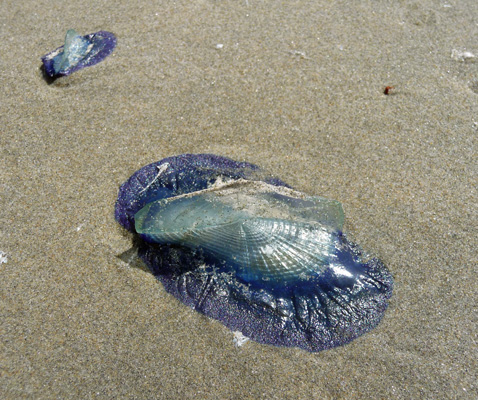
We did our grocery shopping and then stopped by the local True Value Hardware store to pick up a screw (12 cents—the last of the big spenders). While we were at it, I stopped and looked at the folding patio chairs. I’ve been looking for the ‘perfect’ chair for months now. When we were at Pinnacles National Park I saw some that I loved. The folks who had them let me try them on and they’re really comfortable. And it turned out they had just bought them at their local Ace Hardware in San Clemente CA (down in southern CA). I looked for them on-line to no avail and have been checking in stores along the way ever since. Still no luck. But at last here they were and they were on sale! We set them up in the aisle, tried them on and deemed them just what we were looking for. So we bought them for $14.99 a piece. Such a deal.
Here they are set up at our campsite.
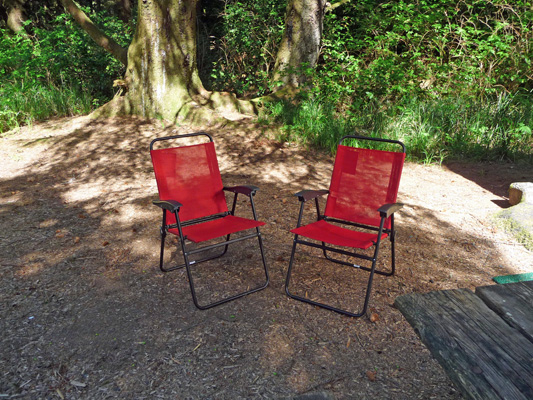
On our way home (with the sun out and most of the clouds having blown away) we stopped off at the Heceta Head Scenic Viewpoint and I shot a photo of the lighthouse and Asst. Keepers’ House.
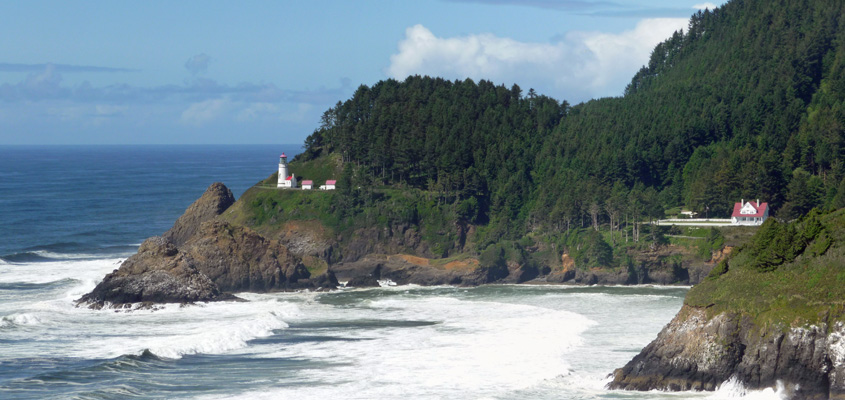
While I was busy taking photos I even managed to get one of the lighthouse when the light was blinking at us.
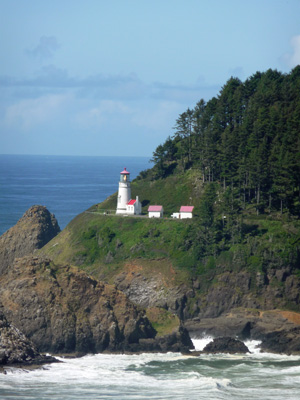
There were cormorants on the rocks down below on the west side of the viewpoint.
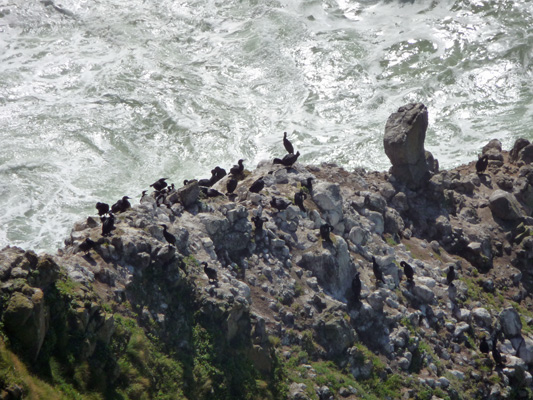
And sea lions (probably Stellar’s sea lions) lounging in large numbers on the rocks to the south not far from the Sea Lion Cave.
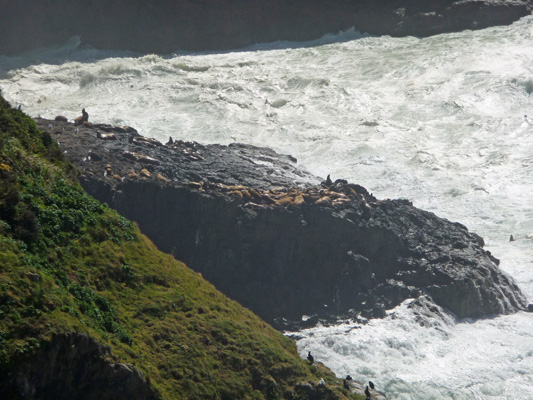
We had a lovely sunny afternoon the rest of the day. I got out and shot a photo of Genevieve and Francois in our campsite (site #57). As you can see, we fill the 40 foot spot right up to the road edge.
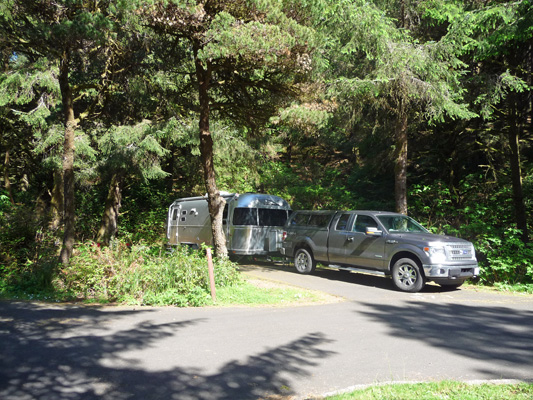
And here’s our campfire/picnic table area complete with our new chairs.
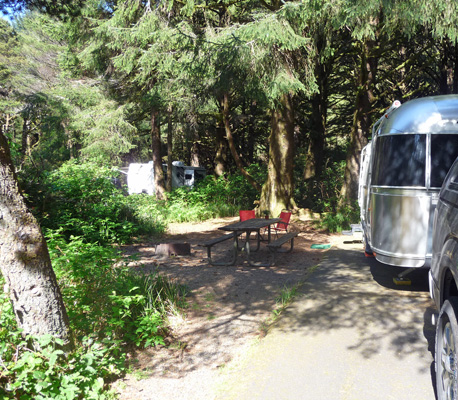
The next morning we awoke to rain on the roof at 7 am and turned over and went back to sleep. Ah the joys of having a down day! When we awoke again, the rain had stopped and by 10:30 am the sun was out again. After breakfast we drove over to the Day Use Area to use the ‘phone booth’ and then swung back past the bathroom in the A Loop so I could start our laundry. They have a free washer and dryer there for the exclusive use of the camp hosts. There are a lot of us this month so we have a sign-up sheet to reserve a time to do it. I had all of Wednesday afternoon to get it done. What heaven.
We puttered along all afternoon, sitting in our new chairs playing music, with me walking back up the hill every so often to tend the laundry. That evening, the folks across from us had a campfire and most of the hosts showed up. Walter and I sang one song (It’s my lazy day) with me playing the autoharp and Walter playing his harmonica on a break. It was well received and we really enjoyed doing it. And Walter has already picked out our song for next week (and changed his mind twice in the meantime.)
Thursday we awoke to another glorious sunny day. They just keep on coming! We were on the morning shift so we set off for the lighthouse at 10:00 and were greeted with low tide when we got to the parking lot.
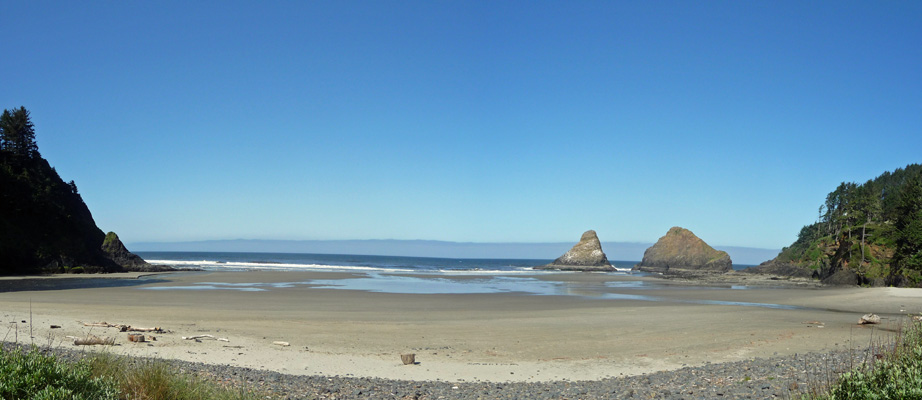
If we’d had time we could have walked out to those big rocks out there. But instead we hustled up the hill to the lighthouse to give tours. There weren’t a lot of folks on this gorgeous morning so I took the time to hike the rather steep trail that takes you up above the lighthouse. And got the lighthouse to blink at me again.
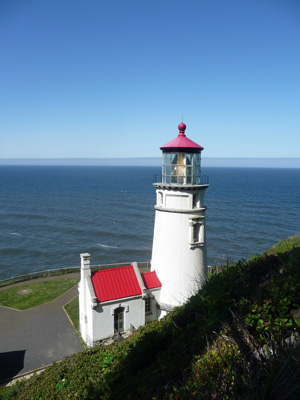
And here’s a close up of the top of the lighthouse and the lens.
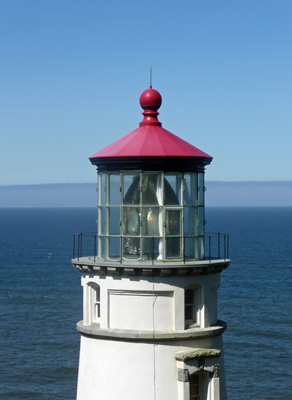
There were Douglas’s Irises (Iris douglasiana) in bloom along the trail.
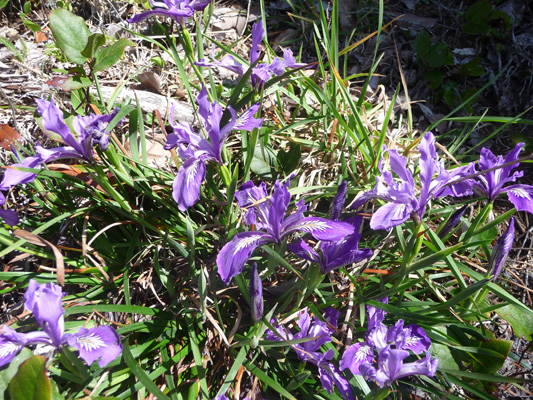
They come in all shades from pale blue and white to dark purple. These are a lovely Dutch blue.
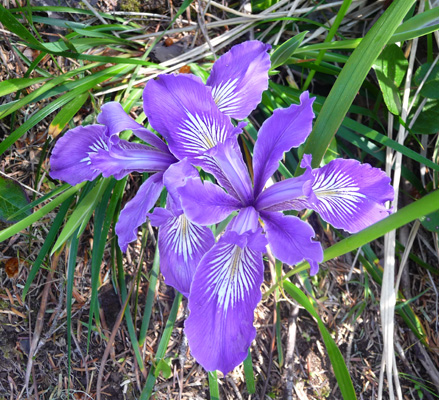
The view southward from here is pretty special too. The red roof below is one of the oil houses.
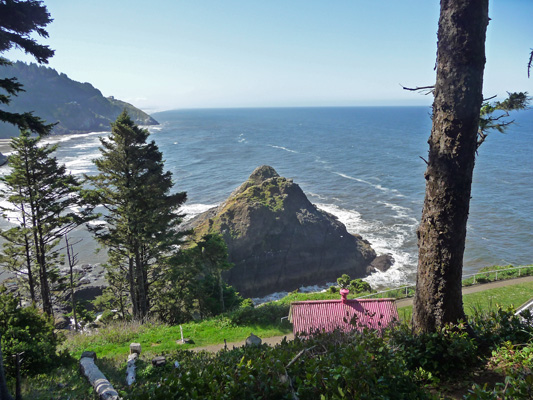
We had a low key day. We had a whale sighting late in the morning. There were 4 of us to give tours and only a couple of our tours had 4 people in them. At 2 pm when the afternoon shift arrived we happily hiked back down to the car and stopped part of the way to catch a photo of the waves as they rolled into the bay.
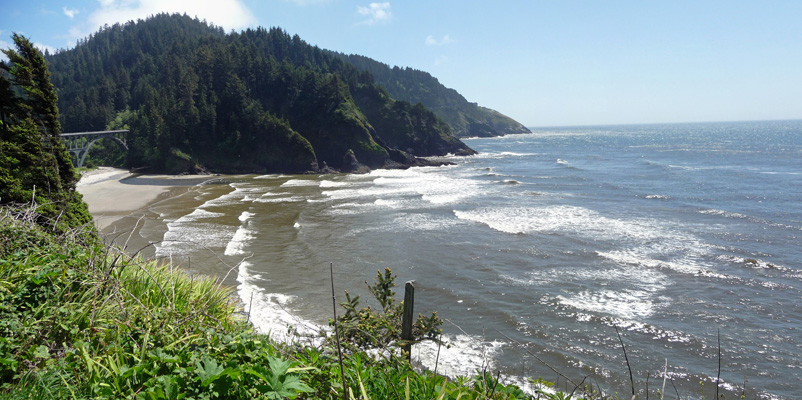
Now that we’ve been at this for a whole week, I think we’re ready to take you on a quick tour of the lighthouse. We both know way too many fun details but we’ll try to keep it short.
The lighthouse was completed in 1894 after a 2 year construction project. They built a wagon road over the headland, the keepers house and the assistant keepers’ duplex, the 2 oil houses and the lighthouse all for the huge sum of $80,000. And $10,000 of that went to the purchase of the first order Fresnel lens from Chase Brothers in England.
The lighthouse was manned by 3 keepers: A head lighthouse keeper and 2 assistants. The keepers worked in shifts. The first shift began an hour before sunset and went to midnight. The second shift began at midnight and went until an hour after sunrise. During the day, they took care of maintenance of the lighthouse, the lens, the lantern and their houses and land. At night they simply tended the light. With 3 keepers it meant that every 3rd night someone actually got to sleep through the night. They were required to have 2 keepers on site at all times to man the 2 shifts (365 days a year). But until the highway was completed in 1931, it took 7 to 9 hours to get from the lighthouse south to Florence, only 13 miles away. The trip had to be made at low tide since they drove part of the way on the beach. That meant it took 2 days to go to town and back. If they’d only had 2 keepers they would never have been able to go to town.
We’ll be heading into the lighthouse through this little house that’s attached to the side of the tower. It holds the Work Room.
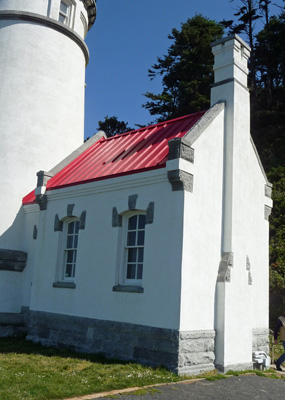
This is where the keeper on duty hung out when he wasn’t up in the tower tending the light. There was a wood stove, a couple of comfortable easy chairs and a small library of books. They could look out one of the two windows and know whether the light was still lit.
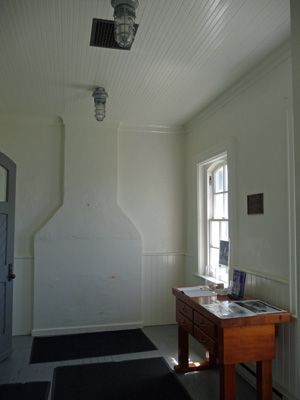
The lighthouse had a kerosene light from 1894 until 1934 when they finally built a power plant here to provide electricity. That meant they had to carry 6 gallons of kerosene up to the light every day (you don’t lug kerosene around at night with open flames around) to fill the reservoir for the night. They also had to clean the lens every morning because kerosene produces a lot of soot.
Each evening the keeper climbed the stairs, lit the 5 wicks on the kerosene light and then cranked up the 200 pound lead weight that was the counter-weight for the clockworks that caused the lens to rotate. Then he would go downstairs to the Work Room and rest until he had to climb the sixty stairs 39 minutes later to crank the weight up again.
Let’s go on into Weight Room at the bottom of the tower.
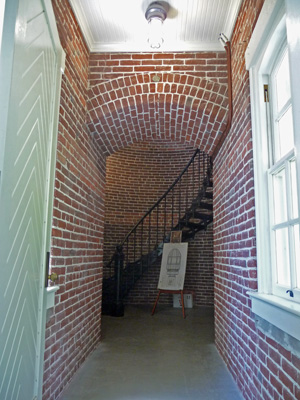
The bricks in the tower came from San Francisco. Originally the entire inside of the tower was whitewashed. After the light was automated in 1963, there was a problem with vandalism and the windows were boarded up. This cut off a lot of the natural circulation in the tower and condensation formed on the walls and the whitewash started to come off. The walls were sand blasted to remove the unsightly whitewash and that took the finish off the bricks. And condensation got worse. They repainted them and the paint kept flaking off. When the tower was renovated in 2011-2013 it was decided to not re-apply the whitewash until the walls fully dry out. So we get to see all this lovely brick.
After a few years of cranking the weight every 39 minutes, someone decided that they could reduce the number of trips up the tower if they cut a hole through the landings in the stairwell and used a longer cable on the weight. Then they would only have to crank up the weight every 2 1/2 hours (some sources say it was every 4 hours). Of course there was a LOT of cranking to do when you did it (over 50 feet of cable) but at least it cut down on the number of trips up and down the stairs.
The stairs are wrought and cast iron and are original. They are not attached to the brick walls. Instead they are hung from the landings. The landings rest on the brick ledges. They did this because the tower ‘breathes’. The bricks expand and contract as they heat and cool each day. But they do it at a different rate than the iron of the stairs. By hanging the stairs it allows everything to expand and contract at their own rates without putting tension on the tower.
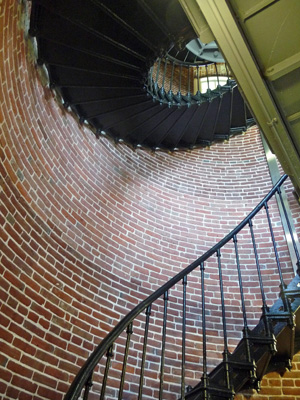
Since the tower is 120 years old and was designed to have 1 or 2 people on the stairs at any given time, we try to avoid wear and tear on the tower and the lens above us, by limiting our tours to 4 to 6 people (1000 pounds). Please walk softly and gently as we go up and down the stairs.
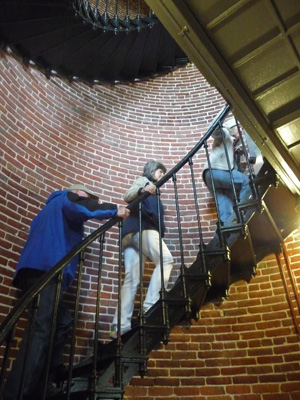
This is the a view of first landing from above. You can see here where the railing had to be re-routed so the weight could go down through the landing.
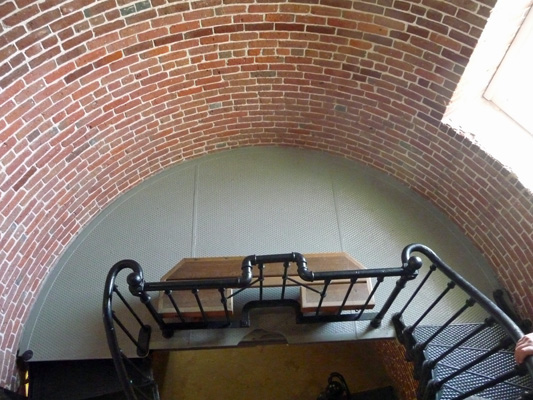
Let’s stop a moment and talk about the construction of the tower. The inside of the tower has fairly straight walls. But if you look at it on the outside it has slanted walls. This is because there’s a second wall on the outside which provides an air space between the outer and inner walls to help reduce condensation. If you look at the window sills you’ll see that they’re really deep giving you a sense of the 2 walls.
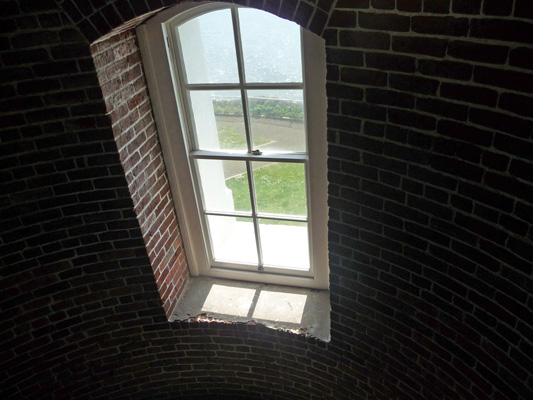
The next level held the service room. They kept their tools here.
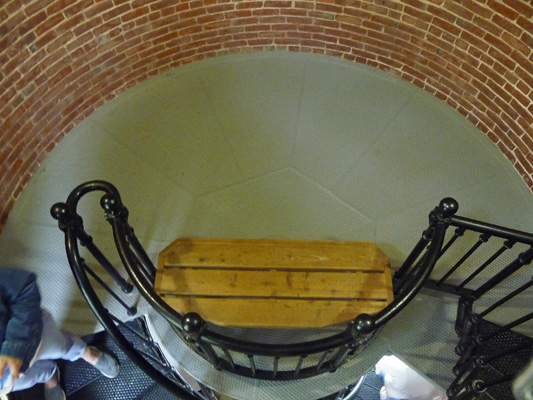
Here you can see that the window sills have gotten narrower as the tower rises. The stairs get narrower too.
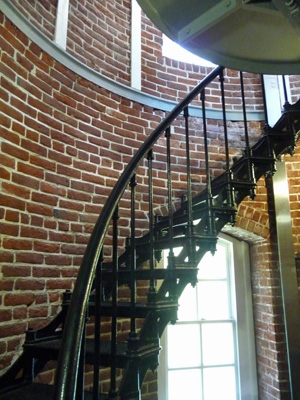
And finally, we climb the stairs to reach the last landing and here is the lens.
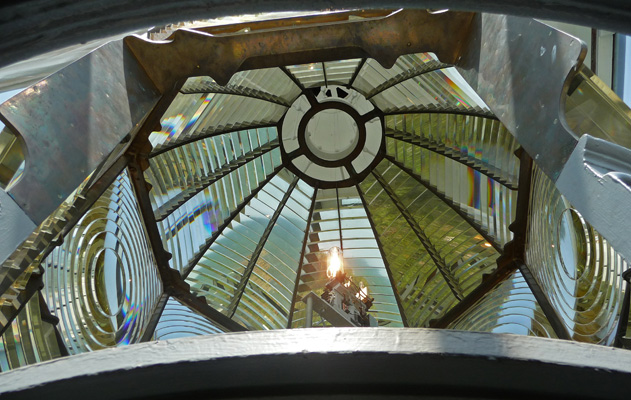
The lens is made of 392 pieces of 2” thick glass. There are 384 prisms and 8 bulls eye lenses. The prisms reflect and refract the light so that as much light as possible is send straight ahead. The bulls eye lenses focus the light coming towards them from the light source in such a way that our experience of the light is that it blinks once every 10 seconds as the lens rotates. In the old days when the lighthouse ran on the clock works, it appeared to blinked once a minute. Once it was motorized they increased the speed at which the lens turns so the light appears to blink more often. The lens works so well that it manages to project 70% of the light from the light source directly out rather than losing a bunch through scatter (which is the opposite of what we want in household lighting where we want lots of scatter to light a whole room).
That’s a 1000 watt quartz light bulb which produces 2.5 million candle power. It can be seen 21 miles out to sea (as long as you’re 15 feet up from sea level). That’s as far as the curvature of the earth will allow. From a plane it appears that the light shines about 40 miles. The original kerosene lamp produced 80,000 candlepower and could be seen 20 miles out.
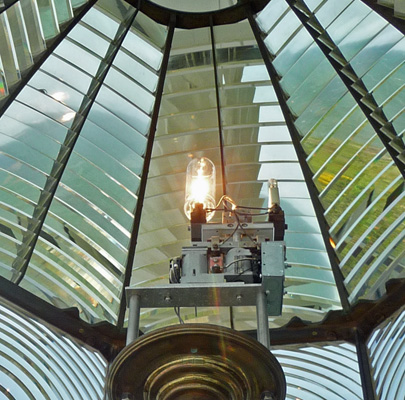
This is the only Chance Brothers English-made first order Fresnel lens still operating in the United States. There are a number of French-made first order Fresnel lenses still operating in the US. You can tell that they are French because their glass has a slight green tinge while the English lenses have a yellow caste from the sulfur the English used to harden the glass.
If it’s sunny afternoon and the angle of the sun is just right we get rainbows on the walls (and the people as they stand looking at the lens) from the prisms in the lens.
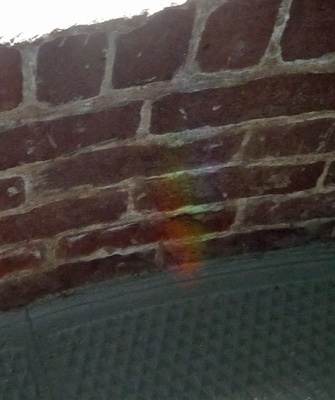
And then the hard part of the tour comes, we have to get folks to stop looking at the view out the window and at the lens and go back down the stairs!
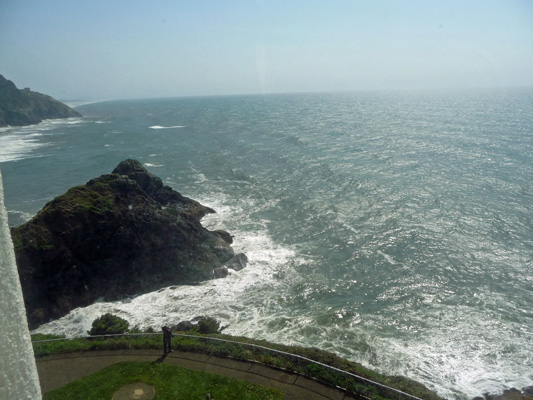
But you get some fun views of the stairs as you climb down. This is heading down to the First Landing from the Service Room and you can see part of the weight room all the way down at the bottom.
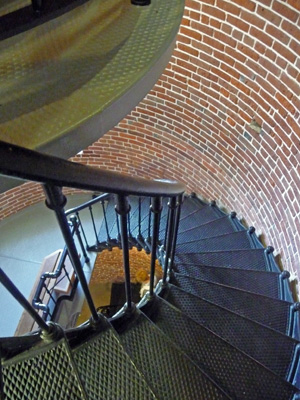
And here’s the last spiral as it heads down into the Weight Room from the First Landing.
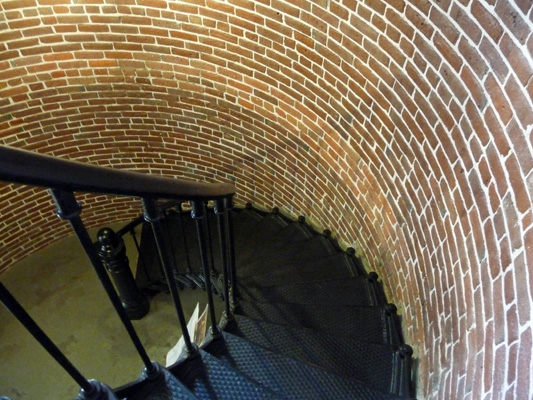
Thanks so much for visiting the light house with us. Don’t you want to make the trip to the Oregon Coast to see it in person now?
Friday morning May 8th (on Walter’s 79th birthday), we had another gloriously beautiful day with a low tide. You could see the water churning between the two rocks near the head as we hiked up the trail.
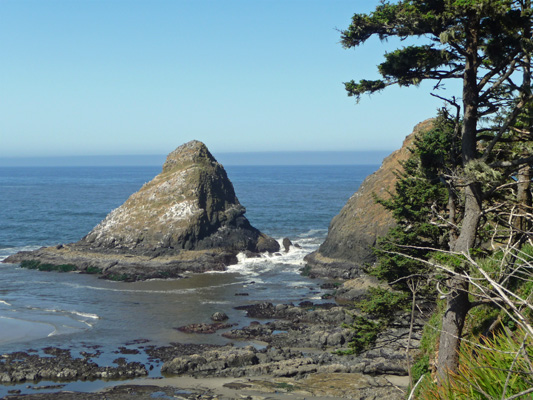
People have said that there is a feature here called Devil’s Churn (not to be confused with a feature up at Cape Perpetual which is also called Devil’s Churn and is best viewed at high tide) and I think that this is the churn here at Heceta Head (but I could be wrong).
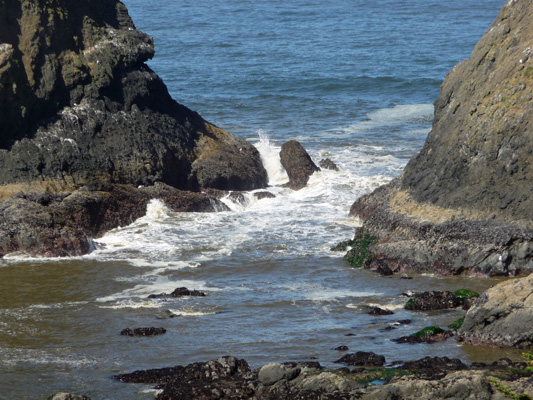
While I was up in the tower that morning, they had yet another whale sighting. This time they saw 2 to 3 as they went north. After our shift ended we headed towards town to make a phone call and ended up going all the way in before we got a decent signal. So we did some errands and had lunch to celebrate Walter’s birthday.
On Saturday May 9th, we awoke to low clouds which slowly burned off as the day went on. We were working the late shift (from 2 to 5:30 pm) so we had the morning to loll around and enjoy ourselves. The sun was out by the time we got to the lighthouse, though there were clouds hung up on the head to the south. But the big news was that they had had a bunch of whales come by earlier in the day. And then just a little after 2 pm we had 5 more swim by. This time they were blowing enough so I tried to get photos. Here you can see two black smears and a white puff. That’s a pair of whales. Probably the one nearer shore is a calf but it’s not really easy to tell here. There were times when you could clearly tell that the one closer to shore was much smaller.
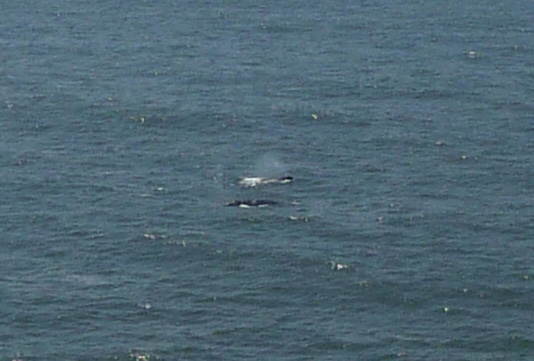
Here you can see 4 of them creating white breaks in the water.
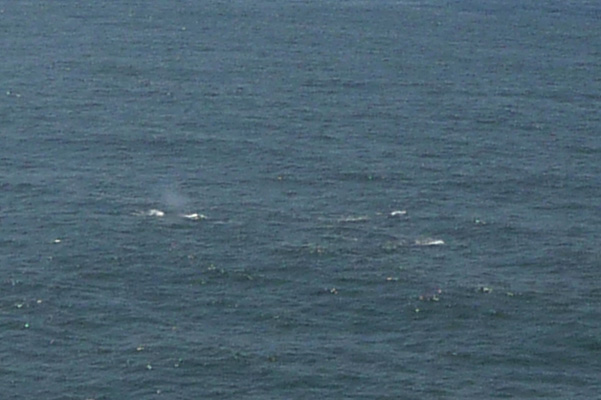
And here are two more as they surface heading northward. I even spied a tail or two, something I hadn’t seen last week.
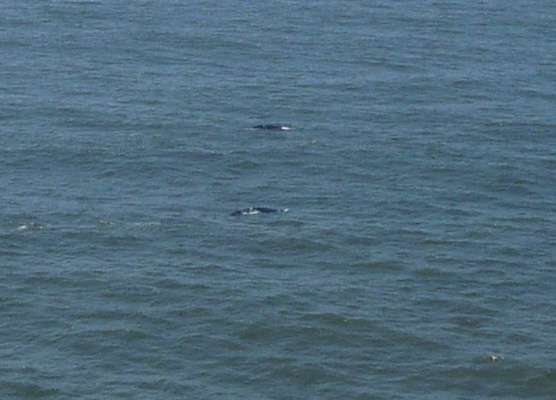
Needless to say they attract a crowd along the fence at the edge of the cliff and no one is much interested in light house tours when you can be watching whales. Once the whales had left we had a fairly busy afternoon. And of course we had two bunches of folks who arrived right before 5 so we ran over in our time. That’s why our shift is short—so we can stay and give tours right up to the time we’re supposed to close.
We stopped by the ‘phone booth’ on the way home and had a super slow signal. I never even got all of my email to download. But we did get to see 3 rabbits busy feeding in the lawn nearby.
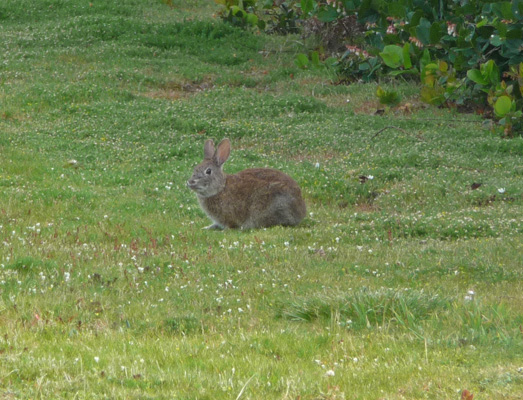
Sunday May 10th it was cloudy. We drove towards town until we had a green signal on our hot spot and then found a spot to park and check our email. It was a nice fast signal and we at least got fairly caught up on the email even if we didn’t make it through all the of Face Book posts.
We were working the late shift again and could barely find a parking spot in the lot when we got there. Happy Mother’s Day! They’d had a busy morning and we had a busy afternoon too even though part of the time we had a heavy mist falling. Clearly going to the coast for the day is a popular thing to do on Mother’s Day. We didn’t see any whales but we had a good day and I learned that they turned off all the lighthouses (on the west coast at least) from December 1941 until August 1945 (during WWII). I learn something new every day on this job.
On Monday May 11th, we drove to Eugene to drop off Walter’s 1975 Martin 00-18 guitar to have a new pick guard installed. It’s plastic and has started to curl up like a Pringles Potato Chip. That turns out to be considered a manufacturing problem and is covered by warranty! That is if Walter remembered to register to guitar back in 1975 when he bought it since there is no way we’re gonna find a receipt from that period back before we were married. Besides if we actually had it, it would be in a box in storage in Monroe.
It was sunny when we left with a few clouds boiling to the north and west. By the time we started heading east, we hit clouds again and it rained off and on all the way to Eugene and back. But when we hit the coast, the sun was out again. It stayed out for much of the afternoon but we did have clouds again by sunset.
We’re really enjoying our stay here at the beach. The lighthouse tours are fun and it’s great to meet so many different people each day. We’re tired at the end of our fourth day of tours and our three days off are very welcome. We both think that a month here will be just right.
